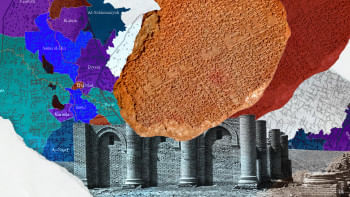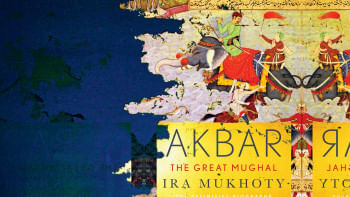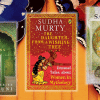Ramayana's evil stepmother redeemed in Vaishnavi Patel's 'Kaikeyi'

In her author's note for Song of Draupadi (Aleph Book Company, 2021), Ira Mukhoty states that for anyone growing up in India (and I would argue, the subcontinent), Hindu mythology is "at once intensely familiar and often deeply obscure". Upon reading this quote, I found myself forced to contend with how loosely familiar I was with the epics that form the core of the world's oldest religion. I felt at a loss as to where to begin with the sprawling dramatis personae and multiple episodic sagas. It felt rather fated that my Instagram began cropping up with reviews of Vaishnavi Patel's debut novel, Kaikeyi (Redhook, 2022).
To understand the plot of Kaikeyi, we need to first revisit the story of Ramayana. The narrative that stays common across the different editions of this epic is that Rama, an incarnation of the god Vishnu, was banished from his home shortly before his coronation. He is accompanied by his wife, Sita, and brother, Lakshmana, during his 14 years of exile. In the last year of his exile, Sita is kidnapped by Ravana, the demon king of Lanka, and it is through the defeat of the monster that the trio are able to return to the kingdom to take their rightful place as royalty. Kaikeyi is Rama's stepmother, and the one who sentenced Rama to his exile so that her own son Bharata could be king.
Kaikeyi is a minor character in Ramayana. She is often vilified for denying Rama his birthright as king and forcing him to spend years banished to a forest. She is perceived as jealous in her actions, and is often believed to be manipulated by her long-term maid and mother-figure, Manthara. However, in all instances prior, Kaikeyi is described as a brave and clever ruler and is very loving towards Rama. Not finding any texts or novels that explain this sudden fall from grace, Vaishnavi Patel decides to retell the events of Ramayana from Kaikeyi's perspective, as she explains in the author's note to her book.
Patel is a talented writer who masterfully weaves in the small nuggets of canon from the Ramayana texts on Kaikeyi's life, against a larger biographical backdrop of neglect and Kaikeyi's own acts of negotiating for freedom and power in a largely patriarchal community. Patel's strong characterisation allows us to watch Kaikeyi grow from a timid young girl to a fierce warrior, saving her husband's life during a battle. She and her sisterwives form an all-women council, which later allows her to become the first woman to take a role in the formal royal council. Her clever administrative decisions help empower the women of her (husband's) kingdom and in turn help the economy flourish. Even her decision to exile Rama is not selfish, and not from her own desire to see her son in power, but a clever political gambit and effort to prevent an attack from her father's kingdom. She sacrifices her social standing and power to try to avoid the possibility of war.
The author takes the brave decision of portraying Ramayana's protagonist, Rama, in a less-than-favourable light. He is shown to uphold patriarchal values and beliefs, in his rule and in his relationships. While he holds his mothers, especially Kaikeyi, in high regard, he protests against women entering the public sphere as it goes against what the Gods ordained.
Now, retellings of Hindu mythology from other perspectives are not new; Michael Madhusudhan Dutt himself wrote a poem from the perspective of the Ramayana's main villain, Ravana. However, in this political climate, the decision to portray one of the Hindu religion's most revered Gods as anything less than perfect, is a bold move. Vaishnavi Patel herself recognises this, stating in an interview that she feels her work is different from that of the books it is often compared to—such as Madeline Miller's Circe (Little, Brown and Company, 2018) or Jennifer Saint's Ariadne (Flatiron Books, 2021)— in that hers is "retelling a myth from a religion that's still very widely practised and has great modern weight. The critiques that the book touches on are grounded in present day interpretation and belief and trying to navigate current religious waters".
As a debut novel, Patel has done a remarkable job in crafting a compelling story through her richly descriptive writing. However, there is room for critique within the core premise of the novel.
In attempting to make us root for and sympathise with our misunderstood protagonist, Kaikeyi's characterisation can feel overcorrected. We are exposed to the narrative from Kaikeyi's point of view, reflecting on her life long after Valmiki had written and unfurled the Ramayana. She is aware of how she is ultimately portrayed in Valmiki's epic—selfish, jealous, and easily-manipulated—and directly raises those points in her narration, providing anecdotal examples of her selfless or caring nature. Kaikeyi learned to fight when other ladies learned to sew; she accompanied her husband to war when her sisterwives did not; she alone took interests in matters of the court—on par with the men.
As her actions are often held against those of her sisterwives and other women in the court, the narration often feels dismissive of anyone who does not actively champion Kaikeyi's personal political agendas. It left me feeling like the novel celebrates the trope of being "not like other girls", particularly women who were perhaps not as privileged as Kaikeyi was as a princess and later, the queen.
Furthermore, Patel includes the added flourish of Kaikeyi wielding magic. The magic brings to view her bonds with people in her life, visualised as thin threads or thick ropes, and allows her to sway people using those bonds. We see her be bold, decisive and strong, but we also see her easily manage this through magical influence. Even when we see the magic fail her, and watch her bonds shatter, it holds little long-term consequence. In fact, we never see Kaikeyi have to truly come to terms with the fact that she effectively manipulated her whole court through magic rather than real effort on her part.
Another unexplored area that I found myself longing for was more nuanced class analysis. In the original myth, Kaikeyi is believed to be manipulated in her decision to exile Rama by her maid Manthara. Patel does a wonderful job of painting Manthara, her childhood caregiver and mother figure, in a firmly positive light. She also introduces us to other kitchen staff and ladies-in-waiting. One is left wondering whether Patel missed the opportunity to have Manthara volunteer to shoulder the blame: stating that as someone from the working class—and presumably a lower caste, Manthara would have less to lose than Kaikeyi. Throughout the book, we are shown that the royals are kind and caring towards their staff, hold them in high esteem, and the different councils work to help the kingdom's people. However, while Patel explores the gender divide in the local markets (which Kaikeyi visits for the first time with Manthara), I was left wishing that it also included a more critical analysis of the disparity in wealth as well.
These critiques are, however, not meant to undermine the importance of Patel's success. The book has managed to break into international fame, being discussed by several reviewers on Instagram and TikTok. It helps invite more people to explore the origins on Hindu mythology, as it did for me, by providing an accessible entry-point. Patel's prose is richly descriptive and feels that stylistically it could fit comfortably on the shelf with other texts on Hindu mythology. Patel also masterfully depicts Kaikeyi as being on the aromantic-asexual spectrum, adding in a slight queer curve to an otherwise strictly heteronormative fiction. Most importantly, it is a well-written story that had me immersed through a very fresh take on a story nearly as old as time.
Selima Sara Kabir is a research associate at the BRAC James P Grant School of Public Health, where she combines her love for reading, writing, and anthropological research.

 For all latest news, follow The Daily Star's Google News channel.
For all latest news, follow The Daily Star's Google News channel. 












Comments